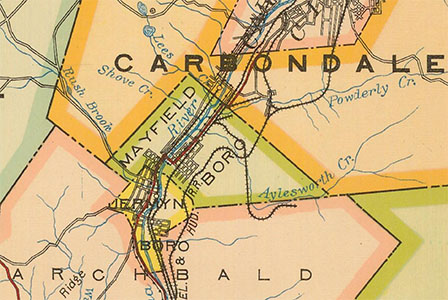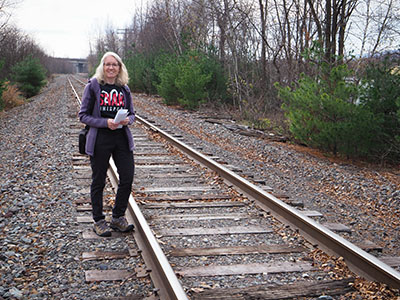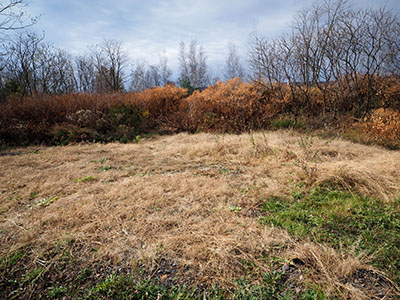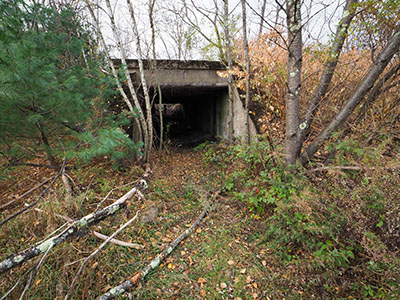TT 9 T
Spatial/elevation data
| Coordinates | N 41.55319° W 75.52214° (estimate) |
| Elevation | 994.829 ft. |
| Location | Pennsylvania
Lackawanna County Carbondale Quad |
Mark description
| Type | Bench Mark Disk |
| Setting | Concrete Post |
| Monumented | 1932 by USGS |
| Description (USGS) | Mayfield, 1.4 mi NE. of; 1.6 mi SW. of Carbondale; on W. side of U.S. Highway 6; between hwy. and D. & H. RR.; 44 ft N. and 19 ft W. from coal track of Powderly Colliery that runs under the D. & H. RR. tracks to coal dump; on RR. property; in concrete post; standard tablet stamped “TT STA NO 9 T 1932” Reference mark; 50 ft NW. of tablet; on lowest stone of E. end of N. abutment of D. & H. RR. overhead bridge at colliery track crossing; chiseled square |
Narrative and photographs
Although we haven’t yet found this mark, the search for it has led to some interesting discoveries (and even more mysteries)! Following last week’s recovery of a local USGS bench mark that we had somehow missed for all of these years, we spent some time poking around on the topo maps to see which other nearby bench marks we might have missed. TT 9 T stood out as one that looked like it should still be in place, and also had some interesting references in its description.
This phrase led us down a rabbit hole:
on W. side of U.S. Highway 6; between hwy. and D. & H. RR.;
Wait, we thought … Route 6 is west of the railroad in this area, so how could the mark be west of the highway and also between the highway and the railroad?
Turns out that Route 6 in this area has been rerouted several times over the years. Originally, it ran through Mayfield on Lackawanna Avenue, then made a jog southeast beneath the railroad overpass on Erie Street, and then turned abruptly northeast to follow Gordon Avenue into Carbondale. This little strip of land between the road and the railroad along Gordon Avenue was where the benchmark was placed. This alignment of the route can be seen on PennDOT’s Historic Type 10 map from 1923.
In the late 1930s, construction of the first section of the Scranton-Carbondale Highway was completed. That section stretched from the southern end of Carbondale Township southwest to present Route 247 (Montdale Road), so it encompassed the section where this benchmark was located. The new alignment is visible on the next available Type 10 map, from 1953.
Interestingly, after finishing our search we took a ride along Upper Powderly Street and returned to Route 6 via Pike Street, which our car navigation unit designates as Route 6 in this area. “What?!” Rich said. “This isn’t Route 6!” In fact, it was for many years … however, since at least 1998 (based on the Historic Type 10 maps) Route 6 has taken its current path over Brooklyn Street/8th Avenue, rather than over Pike Street, into Carbondale. (Shows you how old the data in the navigation unit is!)
Back to the story of our search. Early this afternoon we visited the site, and found easy parking on the east side of Gordon Avenue, just across the road from the coordinates we had pulled from the topo map. We were immediately sure that this would be a difficult, if not impossible, search due to the amount of dense vegetation (“bamboo,” as we call it, or Japanese knotweed). Before trying to make our way to the coordinates, however, we spotted a small opening in the vegetation and walked through to find an old concrete culvert passing beneath the railroad tracks! Could this be the site of the coal track of Powderly Colliery that runs under the D. & H. RR. tracks to coal dump? It seems likely.
Next, we wandered all around the area as much as we could given the dense brush. We climbed up the fill bank to the railroad tracks on top, thinking that we might be able to see down into the vegetation, but we had no luck. The mark is probably still in place, but so covered by fallen leaves and other brush that it will be nearly impossible to find unless there is a brush fire in the area, or someone purchases the land and clears it out. Even a metal detector wouldn’t be of much use since most of the vegetation is just impenetrable.
We may try again, and will certainly keep an eye on the status of this area if we pass by. This would be a fascinating find!






